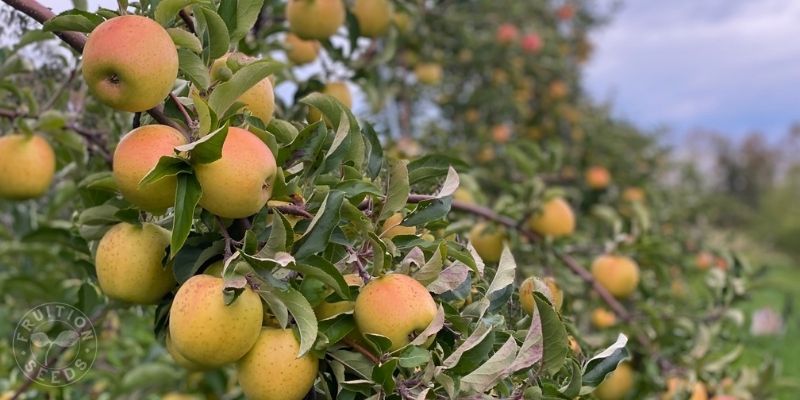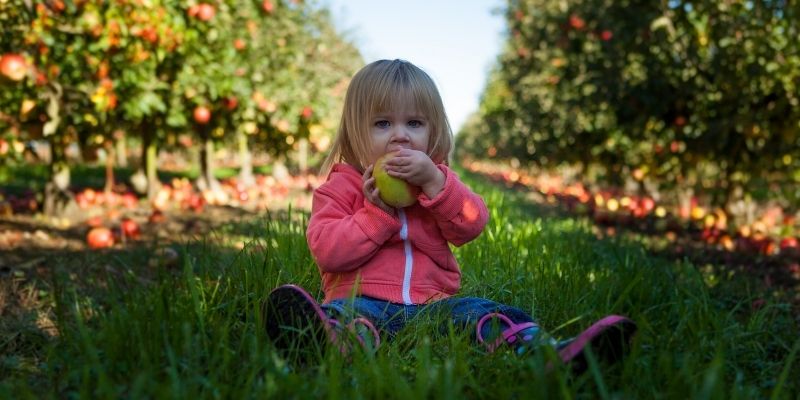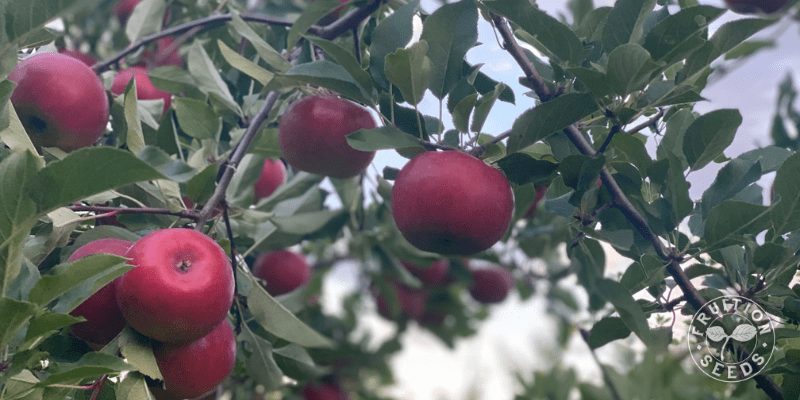Fruition’s current online tree growing resources are focused on Apple Trees (and it is also true that Pears, Plums, Peaches, Apricots and Cherries require much the same site choice, planting, and basic care considerations!) On that note, we hope you'll enjoy Fruition's free full library of Growing Trees Resources. Also recommended are all books by the late Michael Phillips and the online resources at the New England Tree Fruit Management Guide. In the meantime, enjoy more Fruition tree growing resources:
Apple Tree Growing Guide
Fruit Q&Qs pre-recorded Webinar Library
and join us for future live Fruit Q&Q webinars here!
6 Core Questions for Orchard Planning
By Lauren Cormier and Petra Page-Mann
Whether planting one tree or many, a little planning goes a long, long way. The first few years can be the most difficult to get through, when trees are small and still establishing. In these and all the seasons to come, little things you know and do to help your trees thrive will surround us all with the abundance we dream of.
Before we dive deep into details, first envision exactly the kind of place you’re creating: Imagine reaching up, plucking fruit and handing it to a friend. Imagine enjoying them fresh together, laughing as you crunch their juicy sweetness; imagine baking holiday pies with and for people you love. Imagine picnicking under the spring blossoms; imagine being on a ladder to prune — or not! As you imagine the beauty and bounty to come, here are six ‘core’ (ha!) questions to ask yourself.
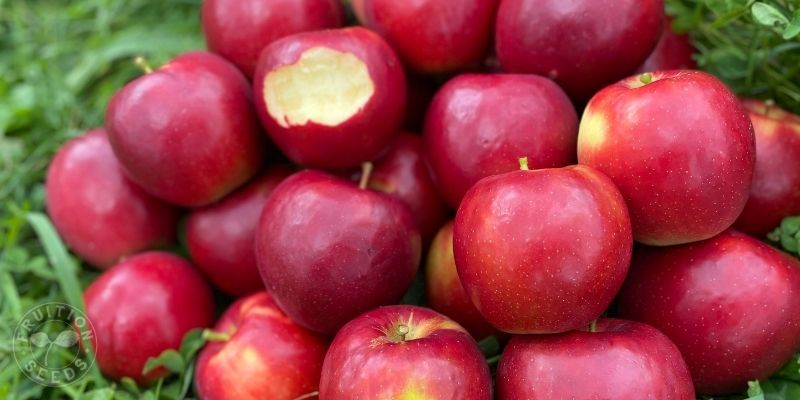
Also, as we begin, let us acknowledge what a privilege — as well as honor — it is to have the opportunity to plant fruit trees. Many of us don’t own or lease land, much less land suitable for apple trees. Even opportunities to plant trees on borrowed land, public land or at the homes of our dearest friends and family may not be possible for many of us. If you are seriously considering planting fruit trees in your life, give thanks and ask, in addition to the ‘practical’ questions: How can the trees we plant amplify the abundance of all? Of all the gifts apples give us, this perhaps is the most vital.
Without further ado, here are 6 core questions to ask yourself as you design your orchard and dream of abundance to come:
1) Where is the best place for a tree (or three)?
Often, as we dream of where we might plant trees, we think of where we want them to be, though this isn’t necessarily where the tree would choose to be. When we think like an apple tree, here’s where we would love to find ourselves:
- Full Sun All day, every day, all year! Imagine all the space for branches full of ripening fruit without competition from other trees above or below ground. Shady spots, or even partially shady spots, are a recipe for disease, lacking nutrition and disappointment.
- Deer Protection Protection from the delighted browse of deer in all seasons is essential.
- Another Apple Nearby Did you know? Apples need at least one other apple of a different variety within 500′ for pollination! It’s true, apples of the same variety will not pollinate each other. Wild and crab apples are marvelous as are planted, named varieties to pollinate each other. If there aren’t any other apples in sight, then plant at least one other variety nearby.
- Water Drainage Well-drained soils grow healthy, expanding root systems with strong anchorage. With all due respect, no puddling please!
- Air Drainage Since frosted blossoms = no fruit, apples thrive above frost pockets. Not too high and not too low, often a gentle slope is an ideal place for apple trees.
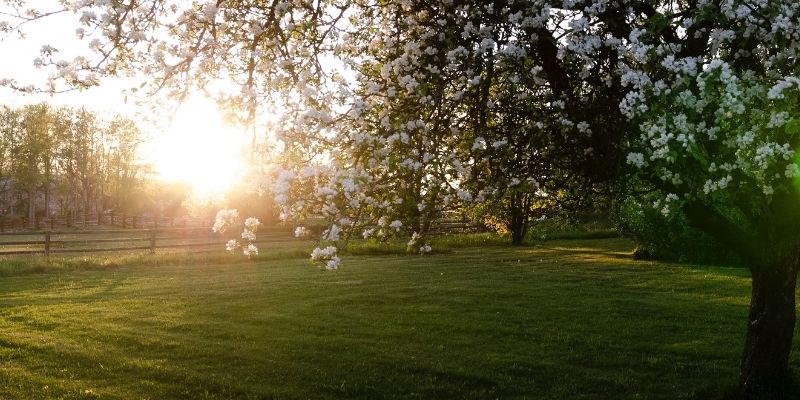
- No Compaction In addition to well-drained, soils compacted by foot traffic or equipment are not good for apple trees unless your soil can be aerated and restored first.
- Plenty of Organic Matter Rich soil with plenty of organic matter and microbial (especially mycelial!) life is optimal for long-term tree health, abundance and longevity. (Hop on over to Soil Testing Made Simple as well as Soil Testing for Trees for more info & insight!)
- Protection from Cold Though many apples thrive in cooler climates (all our varieties are hardy to zone 4), protection from harsh winds, particularly westerly winds in winter, helps them grow stronger and more fruitful.
- Wild Woodsy Meadows are the happy place for apple trees! Rich fungal networks, native herbs, flowers and unmowed areas nearby provide biological diversity as well as habitat for beneficial insects to help keep pest populations at a dull roar.
- Bring Flowers Abundant flowers = abundant nectar, pollen + habitat for countless beneficial species! From companion plants beneath branches to blooms nearby in hedgerows, there is always something flowering for pollinators from early spring through late fall, in the apple’s orchard ~
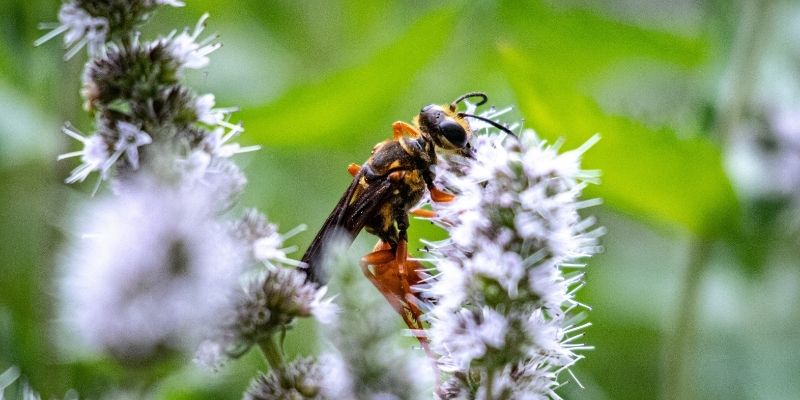
2) Where is the Best Place for Me?
After (and only after!) we consider the tree’s needs, then we consider our own. Let’s be realistic about it:
- Close to Home Are we planting the tree in a place close enough to our home to receive the care and attention it deserves?
- The Better to Mulch You With! How will we get wood chips to the tree? And compost? Is it an easy site to pull up a truck, to wheelbarrow? Slopes can be handy for air drainage…and a lot of work to haul mulch up. The easier you make it for yourself, the more abundant your orchard will be.
- Water Does a hose reach? Is drip irrigation possible? If not, it will be much more challenging to establish your trees.
- Part of the Family Will we be able to enjoy the bright pink buds as they open in spring? See when the baby birds are flying from the nest? Breathe in the sweet fragrance as fruit ripens? Care and attention comes in many forms and goes both ways ~
3) Have you tested your soil yet?
Whether you’re planting one tree or many, the cost of a soil test is a small price to pay for the precision of soil building possible with its insight. Especially if you don’t need to do much amending! But if you do, there is no sharper tool in your tool box.
Enjoy our orchard soil testing blog for all the details, Friends! Doing the soil test well in advance allows time for any amendments to be sourced ahead of planting time. We always test in fall prior to planting in spring. If planting in the fall, hold off to the following spring to fertilize.
One of the greatest gifts you can give yourself and future generations is planting fruit trees…
…and one of the greatest gifts you can give those fruit trees is testing your soil, well prior to planting, and amending your soil…
…so your freshly planted trees will sink their roots into rich fungal soils, establishing quickly to surround you with fruit and beauty for many seasons to come.
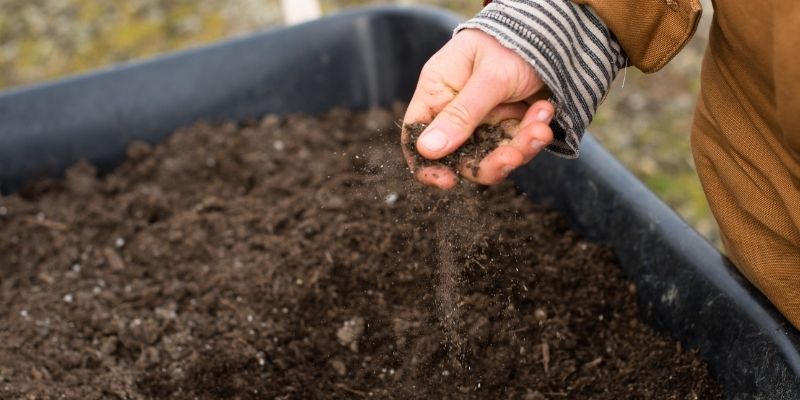
4) What is the long-term maintenance plan?
First and foremost, there’s so much to share! And in the coming weeks, months and seasons ahead, we shall ~
As you begin to create the maintenance plan for your orchard, consider site, available time and varieties planted as well as scale. It’s easy to underestimate the amount of time each tree requires, especially if you’re keen to accompany your trees in all ways and seasons. Even for those of us planting disease resistant varieties to keep the need for spraying minimal (if any!), factor in more time with your trees than you think.
We’ve noticed that small orchards, well tended, are much easier to maintain than those that start too large to maintain and soon get swallowed by grass when not weeded and mulched in time. It’s so hard (what is ‘realistic’ ever?), just try not to plant too much too soon.
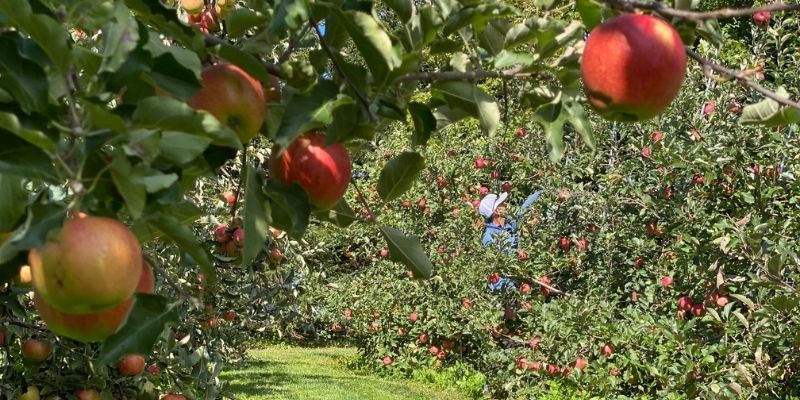
To surround ourselves (and each other!) with the abundance we dream of, our long-term maintenance plan considers each of the following (which we’ll dive into in separate blogs as well as in our upcoming free online course, Organic Apples & Orcharding):
- Mulching with wood chips
- Pest protection
- Weeding, mulching & maintaining tree rings
- Checking for borer
- Spraying
- Pruning
- Thinning
- Harvesting
Keep in mind, the amount of labor (and love!) you’ll need varies depending on the mature size of the tree and staking method. For example, a trellis is going to be much more labor-intensive than planting free standing semi-dwarf trees. However, the semi-dwarfs will later be more work due to their larger size than smaller trees trained along a trellis. We’ll break all this down in a blog to come ~
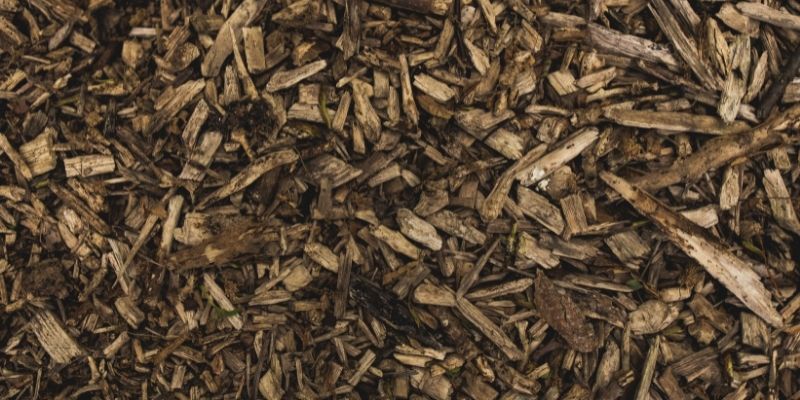
5) Which varieties do we choose?
Friends, there are thousands of apple varieties and deliciousness is in the mouth of the beholder. So many flavors, so many textures, so many shapes! Some of us don’t enjoy eating apples fresh but love pies and making cider. And some of us love all of it, all season long! From branch and cellar to sauce, galette, cider, vinegar, stuffed and baked with nuts and spices, fresh or dried as snacks, we even love tart crabapples in chutney!
Culinary ambitions aside, disease resistant varieties can be much easier to take care of because they don’t need to get sprayed as much, or at all. Many heirloom varieties are also highly disease resistant even though they existed well before today’s modern breeding programs; Fruition will be sharing more of those in the future! Ask other orchardists in the area what has done well for them, and what has not.
Here are a few things to consider when choosing varieties:
- Goals What is your orchard vision? Finding the right balance of flavor, disease and ultimate tree size (rootstock) is key. For you, is flavor more important than disease resistance? If low maintenance is critically important, choose disease resistant varieties. Rootstocks determine ultimate tree size from dwarf (10- to 12′), semidwarf (10 to 16′) to standard (full-size). We’ll share more about rootstocks soon! All of Fruition’s apples are both delicious as well as disease-resistant, each with their own unique nuances and qualities, all on easy-to-grow and quickly fruiting semidwarf rootstock. We’d love to see you here on the farm for a taste test here one day!
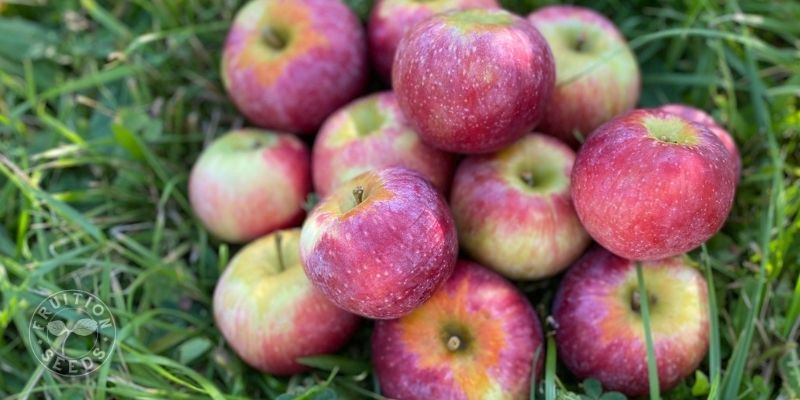
- Disease Resistance Some of the modern varieties, released over the past 50 years or so, are resistant to scab and other apple diseases. Some common pathogens, like cedar apple rust, only occur only in specific locations, so ask around and see what other orchardists in the area have experienced. Some highly disease resistant varieties include Enterprise, Galarina, and Cornell’s latest release, Cordera.
- Purpose Do you dream of your own apples for fresh eating in fall as well as fresh from the cellar all winter? Are you passionate about baking pies? Would you love to press your own cider or dry them for crunchy sweet snacks? There are so many different uses for apples! Some varieties are particularly excellent in very specific ways while others are ‘all-purpose’ and enjoyed in many ways. We love to grow many different varieties to savor all the ways apples bring sweetness to our lives ~
- Season Here in Zone 5, apple harvest extends August through November. Summer apples kick off the season early when it still feels hot and summery. While they are incredibly refreshing, most varieties tend to ripen quickly and turn to mush in a couple of weeks. Many mid-season varieties are considered dessert apples due to their incredible flavor and are best eaten fresh in fall and early winter. Winter apples, or late varieties, are usually harvested in October and early November and keep all through the winter, sometimes until spring. Consider seasonality as you choose your varieties! We’ve planted a diverse orchard so we can savor the spectrum of flavors as well as extended harvest.
- Cold Hardiness Apples are grown from Alaska to Guatemala! Some apple varieties do well in a wide range of climates; others thrive either in the north or in the south. All Fruition’s apple varieties thrive in short seasons, hardy to zone 5. If you’re sourcing apples elsewhere, read variety descriptions closely from numerous sources to be sure you’re planting varieties well suited for your location.
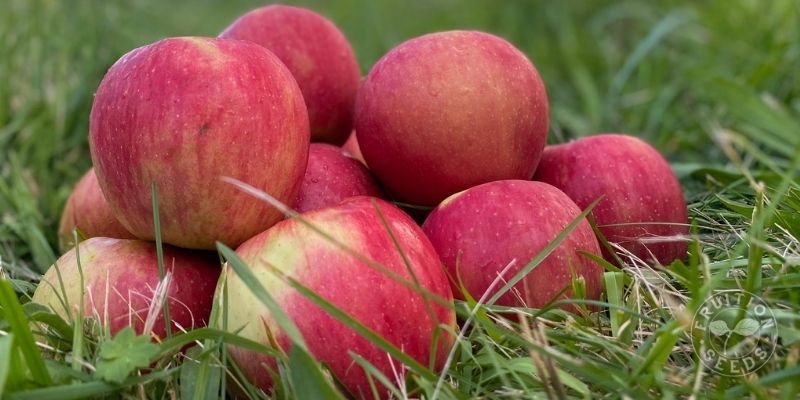
6) What spacing & trellising (if any) are best?
The larger the tree, the further space it will need between other trees, buildings, fences, and gardens. For backyard orchards, we recommend a minimum of 12 to 15 feet of space for each tree on semi-dwarfing rootstock. If trees are being trellised or espaliered, they can be spaced as close as 4 feet apart. Doing a little research on spacing and staking recommendations for specific rootstocks is helpful, each one is a little different. We’ll be sharing more about how we recommend staking and spacing our semi-dwarf trees, stay tuned!
If your trees are planted in rows, base the spacing between rows on whether a lawn mower, tractor, or scythe will be used to mow between trees and rows. Many orchards space their rows 20 feet wide for both dwarfing and semi-dwarfing trees. If free standing semi-dwarfs are being planted, determine if mowing will happen between trees or just between rows. Larger semi-dwarfs often get planted with 15 to 20 feet between trees in the row. First, determine which rootstocks are available and then choose one, or try a few, that work with the general size tree desired and the long-term orchard vision.
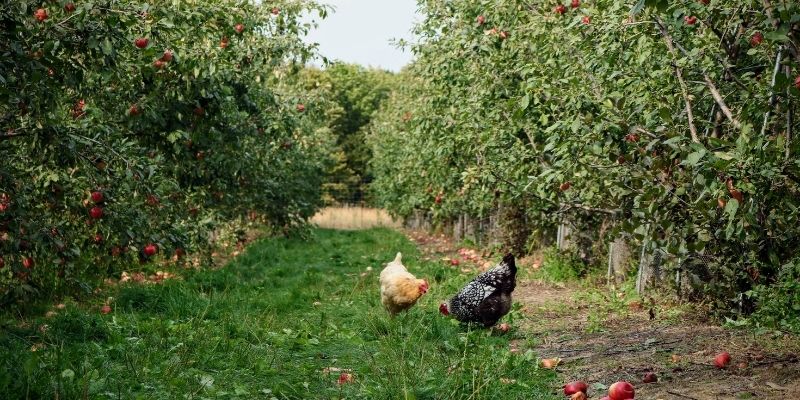
Friends, there are so many variables, considerations and implications of each of our actions and the orchard is no exception. It’s a vast equation! And not a decision to rush. Starting small with ease of access, centering the needs of your tree over your own, will go far in surrounding you with joy as well as abundance.
Have confidence that trees give back the love they receive, especially in the first few years, as both are learning each other’s rhythms and needs. With a bit of planning, preparation, curiosity and a sense of adventure, you’ll be nourished by your trees in so many ways for many, many seasons to come…
…and we’re so honored to join you!
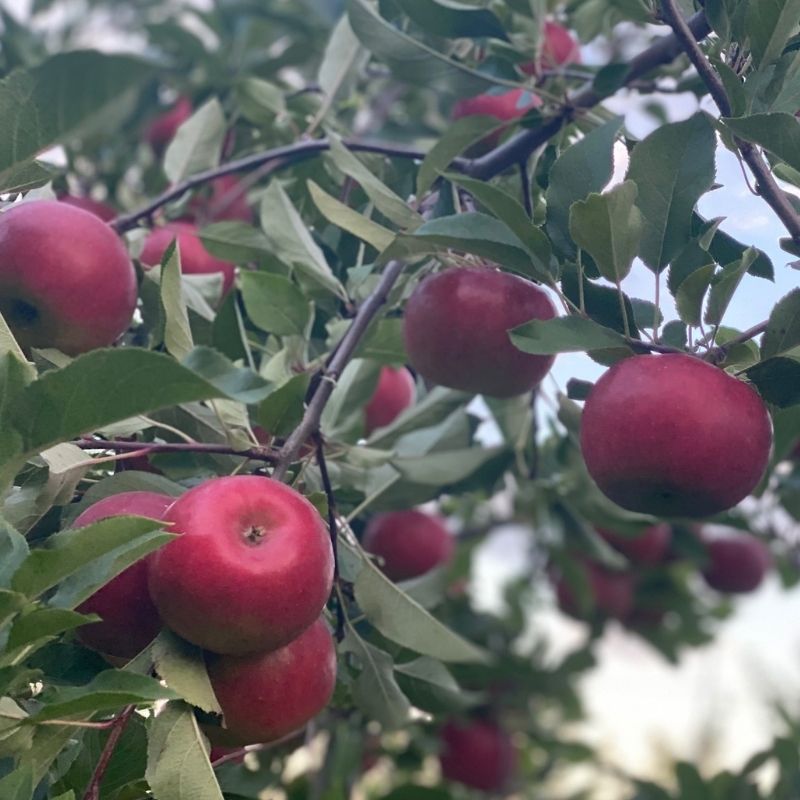
Be in the know:
Fruition's Fruit Tree Updates!
You'll receive seasonal tree insights & how-to's plus be the first to know about invitations to tree events on-farm and online!
Visit our newsletter website and subscribe to the 'Tree Updates' section
Enjoy our free online Apples & Organic Orcharding course and Tree Webinar Q&Qs Library in the meantime & don't be shy!
~When you join us, check your inbox for your welcome & access info! Stay tuned for our weekly organic gardening tips & inspiration, as well~
Sow Seeds & Sing Songs,

& the whole Fruition crew

